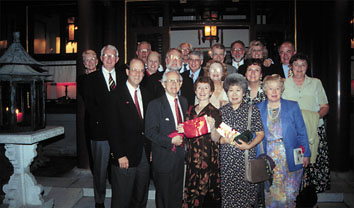

Now is the time to plan your own travels with Carnegie Museums. These tours are tailored to the interests of our members, and draw upon the expertise and world-wide connections of our own Carnegie Museums staff. See the list of future tours at the end of "China Diary."
—Ed.
Preparatory comments about the People's Republic of China were not flattering to that country. Hepatitis…people spit…they push their way into lines, don't know how to queue up. Carry Vicks Vapo-Rub, someone advised me. A dash under my nose at night would disguise unpleasant local odors. A few refused to consider the trip…"the last time, my husband saw rats in the hotel." Current travel literature warned that we might be moved from passenger to military aircraft, and that flights were often cancelled without explanation.
Well-armed with an array of concerns, our Carnegie Museums group of 18 embarked on a two-week tour led by Abercrombie & Kent and an indomitable Chinese-American guide named Margaret Chen Turner. As insulated voyeurs staying in hotels equal to fine American lodging, we avoided the trauma of predictions and witnessed a country of remarkable scale, economic energy and determination. To a person, we returned home carrying indelible images of a strange and wonderful land.
 |
• Shanghai, a seaport of raw energy, determined to displace Hong Kong as shipping tonnage leader; home of the sophisticated Shanghai Museum, which reopened in new quarters in 1996 with outstanding collections of bronze, ceramics, painting, and calligraphy.
• Chongqing, industrial gray, too hilly for bicycles, with a point of embarkation down a treacherous half mile of steps to the Yangze and our great white boat, the MS Queen.
• The Yangze and its Gorges, somber under driven rain, endlessly beautiful.
 |
• Xi'an, city of clay: brick walls and buildings, warriors, burial mounds, and conspicuous tourists.
• Beijing, capital city, welcoming city, Forbidden City, Summer Palace city, more cars, more bicycles, more VIPs, and near the Great Wall.
Carnegie Museums sponsors a variety of trips each year. We chose China because we were eager to see the Three Gorges prior to the completion of the great dam; and we believed that we could leverage unusual opportunities for our group because of our Chinese contacts. Several Chinese citizens work at Carnegie Museum of Natural History, which sends scientists to China annually on a quest for the fossils of early mammals that coexisted with late-period dinosaurs.
Our expectations were fulfilled. We gained access to closed rooms in the Forbidden City: the "office" of the "last emperor" (see the movie), concubines' heated bathhouse (empty!), traveling exhibitions in preparation. We climbed an isolated section of the Great Wall, and half of us rappelled down a tower to the ground.
We met special people: Dr. Li Chao Yuan, deputy director of the Shanghai Museum, who took us to private quarters for our orientation; Prof. Wang Xue Li, head of Xi'an's terra cotta warriors archaeology team, who hosted us for tea; Madam Ding Hua, Wuhan's famous if unofficial hostess, who specified a formal dinner of spectacular presentation; Qian Yun Lu, secretary of the Wuhan Municipal Committee of the Chinese Communist Party and host for a formal lunch; small children who danced, plucked, and sang to us; and "Sunny" Sun, our official Beijing CITS guide. Sunny was smart, confident, and candid, and she aspired to open her own travel agency, which is now permissible in China.
Images continue to tumble through the mind, for China is a land of consistent and powerful architecture, of stark contrasts: limousines crawling patiently behind the human-drawn dray carts passing a five-star hotel; limited amenities and a clean, polite people; the brooding, heavy beauty of the Gorges, and the power of the new Yangze dam, the largest construction site in human history.
We were amazed by the country's active reconstruction of its treasures for Chinese and tourist alike, while studiously failing to maintain its buildings. The extraordinary number of construction cranes and the lashed bamboo scaffolding rising up with it impressed us.
Most of all, we were taken by the gentleness and kindness of people who worked hard and served cheerfully; by the economic energy unleashed in the land; and by the continuous, panoramic, public living in contrasts of rich and poor, of countless people everywhere we went.
I might add, personally, that the Carnegie entourage harbored good cheer
and mutual respect, and was always eager to shop and to see the next site
the guides would invariably call out, with common accent, as "farmers and
popler." China is now better understood and will remain, "famous and popular"
for us. There is mounting demand for a trek over the Great Silk Road next.
Please consider one of our Carnegie trips. Each will be memorable
in its own way.
Contents |
Highlights |
Calendar |
Back Issues |
Museums |